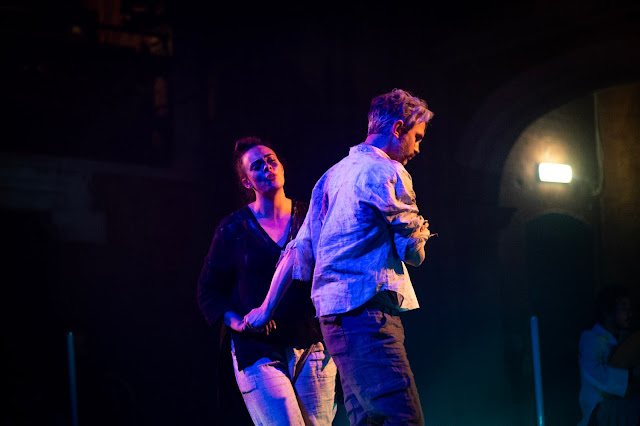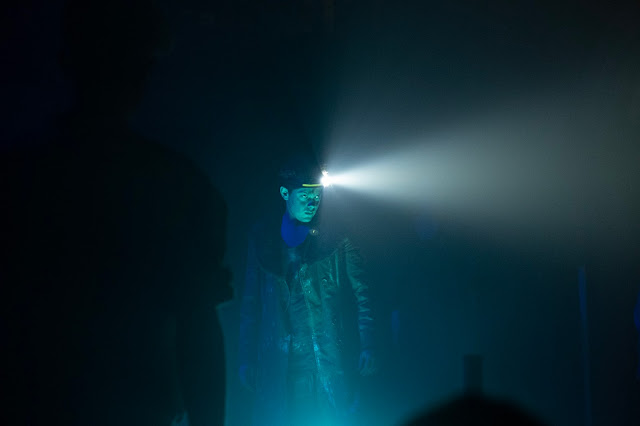 |
| Handel: Acis & Galatea - London Handel Festival (Photo Matthew Thompson) |
George Frideric Handel: Acis & Galatea (1718)
Anthony Gregory, Madison Nonoa, Will Thomas, director: Andy Staples, La Nuova Musica, music director: David Bates
London Handel Festival at Stone Nest, 1 April 2022 (★★★★)
We don't know much about the first performance (in 1718) of Handel's pastoral Acis and Galatea but there is a tradition that it was premiered in the gardens of Cannons, the grand house created by the Duke of Chandos, under whose patronage the work was created. This lack of specifics (even the work's form is up for grabs) provides both a challenge and an opportunity for directors.
The London Handel Festival's production of the Cannons version of Handel's Acis and Galatea was presented in the distressed grandeur of Stone Nest, a former church turned night club now reinvented as an arts venue. We caught the second performance on 1 April 2022. Andy Staples directed with La Nuova Musica, musical director David Bates, with Anthony Gregory as Acis, Madison Nonoa as Galatea, Will Thomas as Polyphemus, James Way as Damon, David Webb as Coridon and dancers Sean Murray and Patricia Langa.
So, what exactly does the Cannons version mean? Well, five singers (soprano, three tenors and a bass) who double as chorus and soloists, a tiny instrumental ensemble with one instrument to a part (Matthew Truscott & Andrej Kapor violin, Martyna Jankowska cello, Judith Evans double bass, Katharina Spreckelsen & Sarah Humphrys oboe/recorder, Sergio Bucheli theorbo, William Cole harpsichord, directed from the harpsichord by David Bates). In addition to Acis, Galatea and Polyphemus there are two extra characters, Damon and Coridon whose arias counsel patience to the impetuous Acis. Coridon would disappear in Handel's revisions to the work in the 1730s.
 |
| Handel: Acis & Galatea - Madison Nonoa, Anthony Gregory - London Handel Festival (Photo Matthew Thompson) |
This version is variously described as a serenata, a pastoral, and a masque. The text (by John Gay with additions by John Hughes and Alexander Pope with borrowings from Dryden's translation of Ovid) clearly nods at the masque form but is influenced by the more recent tradition of pastoral opera and compared to late 17th century English opera there is a remarkable lack of dance movements.
Andy Staples' production (no designer was credited) moved the work well away from the pastoral. The acting area was a central circle of sand delineated by rope, with the audience on three sides (and up on the balcony) and the instruments on the fourth side. This performing in the round gave a sense of immediacy but meant that no-one had a perfect view of the action. Sight lines beyond the first row of seats were patchy, and those of us on the first row were in constant danger of tripping up the performers.
Costumes were rough and generic, just worn tops and cropped trousers with bare feet. Instead of pastoral (Acis is a shepherd, Galatea a nymph) we had a sense of ritual. The production opened and closed with a soundscape and Madison Nonoa's Galatea in contemplation at the centre of the circle. Staples introduced two dancers, Sean Murray, and Patricia Langa (no choreographer was credited) who were a constant presence. They seemed to be doppelgangers for the two protagonists; at the opening when Acis and Galatea were apart, each singer sang their aria to the opposite doppelganger so that Madison Nonoa sang to Sean Murray, i.e. to a man who was clearly not Anthony Gregory leading to a degree of confusion in this reviewer's mind at least.
 |
| Handel: Acis & Galatea - James Way - London Handel Festival (Photo Matthew Thompson) |
This sense of ritual threaded its way through the whole production, a sense of significant movement throughout. At times, in Act One, this created an evocative rather contemplative atmosphere, but at other times I found the action distracting. It might have seemed a good idea to end Act One by wrapping the two lovers, during their duet, with lots of rope but it seemed at odds with the music. Then in Act Two, Staples used the cast to create a group of followers for Polyphemus, a neatly effective touch, but the concept was perhaps over-used, and I found the action in this act over busy and too distracting. Sean Murray raking the sand with an illuminated rake might have been a striking image, but I felt that it was somewhat unfair to Madison Nonoa who was singing Galatea's final aria at the same time.
The performance ended not with the last note of Handel's music but returning to the sound-scape with Madison Nonoa contemplating a fire at the centre of the circle. This seemed, frankly, the wrong image; Galatea is a water nymph, the opera ends with her transforming Acis into a stream.
What lifted the evening, for me, were the musical performances. It was clear that Staples and David Bates had a strongly dramatic view of the work, and much of the evening was vividly performed, highly engaging and engaged, on a very high musico-dramatic level.
 |
| Handel: Acis & Galatea - Anthony Gregory, Madison Nonoa - London Handel Festival (Photo Matthew Thompson) |
Anthony Gregory was quite a virile Acis, well away from the soppy wimp that the character can be, and Gregory's performance reminded me of his fine accounts of haut contre roles. He had the ability to sing with great strength of line whilst also shaping the phrase beautifully. And yes, it was haunting too. Madison Nonoa was a very human Galatea, singing with a lovely flexibility and great warmth. This warmth seemed to imbue every single note to lovely effect.
Will Thomas' Polyphemus was wonderfully sung, managing to combine the necessary strength and over dominance with the necessary Handelian style - quite a feat. There was nothing comic about this Polyphemus, nothing of the buffoon, nor was he ugly. In fact, Thomas' Polyphemus was remarkably personable, his ugliness came from the fact that he failed to realise he was unwelcome; this was a very modern reading of the story.
James Way brought a welcome element of vocal drama to his two arias and managed to really engage us even though the dramatic lighting meant that his face was well-nigh invisible. David Webb similarly contributed a strong account of Coridon's aria in Act Two.
 |
| Handel: Acis & Galatea - London Handel Festival (Photo Matthew Thompson) |
The five singers worked well as an ensemble, slipping in and out of roles, and making the choruses something special. The work has a very particular sound, five solo voices in ensemble, no alto and three tenors, and the five gave the music balance and intensity. David Bates (directing from the harpsichord with a second harpsichord played by William Cole) drew finely dramatic playing from his instrumental ensemble, giving a full-blooded feel to the music despite using just eight instrumentalists.
This review also appears in Opera Today.
Never miss out on future posts by following us
The blog is free, but I'd be delighted if you were to show your appreciation by buying me a coffee.
Elsewhere on this blog
- A tradition of excellence in danger of being eroded: the Continuo Foundation started simply as an idea to support the UK's period instrument groups - interview
- Bringing the House Down: bass Brindley Sherratt on the gala at Glyndebourne for The Meath - interview
- You could not help but be won over: Scottish Opera's new Gilbert and Sullivan production parks its gondola at the Hackney Empire - opera review
- New wine in old bottles: ORA Singers in Victoria's Marian motets and newly commissioned modern reflections - record review
- A programme of Bach's concertos and cello suite from Il Gusto Barocco gives us a distant echo of Bach's concerts at Cafe Zimmerman - record review
- The Library of a Prussian Princess: Ensemble Augelletti evoke late 18th century musical soirees that explored music of Bach, Handel and more - record review
- From Melissa to Musetta: I chat to Irish soprano Anna Devin about the joy of singing with Irish National Opera, returning to Puccini, having a Donizetti moment and her love of Baroque opera - interview
- Earth's Wide Bounds: William Vann & the Chapel Choir of the Royal Hospital, Chelsea in RVW's Communion Service in G minor - record review
- Writing against the grain: late-romantic horn concertos by Malcolm Arnold, Christoph Schönberger & Ruth Gipps from Ben Goldscheider - record review
- Portuguese violinist Bruno Monteiro in a striking programme of three major early 20th century violin sonatas, from Portugal, France and Brazil - record review
- Fidelio Trio explores Moeran's early chamber music, revealing a mix of Romantic harmonies, Continental influences and a sense of engagement with Irish musical culture - record review
- Le Destin du nouveau siècle: a hitherto unknown opera-ballet by André Campra provides a glimpse into the largest Jesuit teaching institution in Paris, and some engaging music - record review
- He enjoys the way his composition now touches lots of different worlds: I chat to Pascal Schumacher about his latest album - interview
- Home








%20as%20Leporello%20and%20Erik%20Tofte%20(back%20to%20camera%20in%20garnet%20shirt)%20as%20Giovanni%20-%20Don%20Giovanni.jpg)


No comments:
Post a Comment